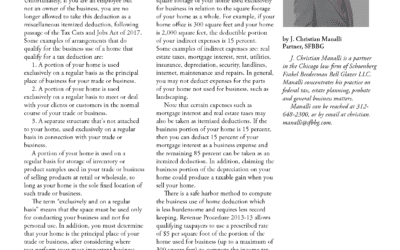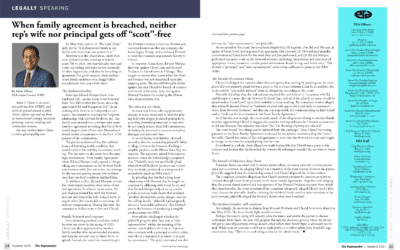I. PURPOSES OF STOCK RESTRICTION AGREEMENTS (A/K/A BUY/SELL AGREEMENTS)
A. Created to provide for purchase of shares of departing shareholder of closely-held corporation.
B. Corporation or shareholders often purchase insurance to finance repurchase of shares of deceased or disabled shareholder.
C. Stock restriction agreements essential for closely held corporation with more than one shareholder by:
1. Providing for proper succession of business to remaining shareholders;
2. Providing liquid assets for family members of deceased or disabled shareholder; and
3. Preventing sale of corporation for sole purpose of redeeming deceased or disabled shareholder’s shares.
II. KEY PROVISIONS OF STOCK RESTRICTION AGREEMENTS
A. Restrict share transfers to third parties
B. Provide for purchase of shares upon occurrence of specified events (death, disability, retirement, employment termination, loss of license, etc.)
C. Specify purchase and sale price and other terms
D. Identify party obligated to consummate purchase
E. Specify funding mechanism
III. TYPES OF STOCK RESTRICTION AGREEMENTS
A. Stock Redemption Agreements
1. Closely held corporation purchases shares of departing shareholder.
2. Shares purchased by corporation generally cancelled and remaining shareholders own greater percentage of corporation’s outstanding shares.
3. Holder of departing shareholder’s shares surrenders shares in return for proceeds from sale.
B. Cross Purchase Agreements
1. Remaining shareholders of closely-held corporation directly purchase shares of departing shareholder.
2. Unlike purchase pursuant to stock redemption agreement, remaining shareholders in cross purchase arrangement purchase shares and holder of departing shareholder’s shares transfers shares to purchasing shareholders.
3. No cancellation of shares as surviving shareholders become owners of departing shareholder’s shares.
C. Hybrid Arrangements
1. Certain events trigger purchase obligation of corporation while other events trigger purchase obligation of remaining shareholders.
2. Agreement has some characteristics of stock restriction arrangement and some characteristics of cross-purchase arrangement.
IV. SELECTING APPROPRIATE STOCK RESTRICTION AGREEMENT
A. Alternative Minimum Taxes
1. While corporation’s receipt of insurance proceeds upon disability of shareholder generally not subject to income taxes (Code Section 104(a)(3)), insuranceproceeds received by corporation may be subject to alternative minimum taxes (Code Section 56(g)).
a. Corporations not subject to alternative minimum taxes for subsequent years provided gross receipts for all preceding three (3) year tax periods do not exceed $7,500,000 (Code Section 55(e)(1)(A)).
b. Corporations which satisfy $5,000,000 gross receipts test for first three (3) taxable year period not subject to alternative minimum taxes (Code Section 55(e)(1)(A))
c. Corporations are exempt from alternative minimum taxes for first year of existence (Code Section 55(e)(1)(c)).
2. Alternative minimum taxes more likely to be imposed where corporation pays little or no Federal income taxes.
3. Where large insurance policy procured upon shareholder of closely-held corporation and corporation likely subject to alternative minimum taxes upon receipt of proceeds, cross purchase agreement may be preferable to stock redemption agreement.
B. S Corporations
1. Since S corporations not subject to alternative minimum taxes, stock redemption agreements can generally be used without concern for incurring tax liability upon receipt of insurance proceeds (Code Section 1363(a)).
2. Frequently beneficial for closely-held corporation to convert to S corporation status to avoid alternative minimum taxes on collection of insurance proceeds.
C. Basis Step-Up
1. If corporation repurchases shares of departing shareholder, no increase in income tax basis of shareholdings of remaining shareholders.
2. Where remaining shareholders purchase shares of departing shareholder, remaining shareholders benefit from higher income tax basis in shares as result of purchase.
3. Where sale of stock or assets of corporation contemplated after departure of shareholder, remaining shareholders may realize greater income tax benefit by purchasing departing shareholder’s shares pursuant to cross purchase agreement.
D. Dividend Treatment
1. Distributions to shareholder in payment for shareholder’s stock treated as paid in exchange for such stock (e.g. proceeds from sale of capital asset) if any one of statutory tests satisfied(Code Section 302(a)).
a. Distribution not substantially equivalent to dividend;
b. Shareholder’s share ownership decreases by not less than specified percentage; or
c. Shareholder completely terminates interest in corporation.
2. In determining whether requirements satisfied, shares owned by certain family members taken into account (Code Section 302(c)(1)).
3. If distribution does not constitute payment in exchange for shareholder’s stock, distribution treated as dividend to shareholder to extent of corporation’s accumulated earnings and profits (Code Section 301).
4. Where closely-held corporation owned by family members, distribution in redemption of departing shareholder’s stock may be treated as dividend rather than as payment in exchange for stock.
5. Departing shareholder may recognize ordinary income from distribution rather than receiving proceeds attributable to sale of capital asset.
6. Shareholders of closely-held corporation facing dividend consequences from stock redemption may be better served by utilizing cross purchase agreement where payments made by remaining shareholders, not corporation.
E. Number of Shareholders
1. Where two shareholders in corporation, relatively easy to utilize cross purchase agreement.
2. Where more than two shareholders, difficulties may result from implementing cross purchase agreement, particularly where insurance is intended to fund buyout.
Example. If A, B and C each own shares in corporation and intend to implement cross purchase agreement, A must own policies on B and C, B must own policies on A and C and C must own policies on A and B. In short, six policies required where only three policies required to fund stock redemption agreement.
F. Protection of Insurance Policies From Creditors
1. Insurance policies owned by corporation subject to claims of corporation’s creditors.
2. Insurance policies owned by shareholders subject to claims of shareholders’ creditors.
V. CHOOSING VALUATION METHOD
A. Stock in closely-held corporations not susceptible to ready valuation.
B. Stock restriction agreement designed to determine method of valuing shares of closely-held corporation.
C. Most common techniques are formula-based value, agreed value and appraised value.
D. Method selected should be periodically reviewed to assure that appropriate insurance or other funding available to finance buyout.
VI. S CORPORATION SHAREHOLDER ISSUES
A. Only individuals, estates and certain trusts permitted to own S corporation shares.
B. Stock restriction agreement should restrict transfers of S corporation shares to ineligible shareholders.
C. Qualified subchapter S trusts (“QSSTs”) permitted S corporation shareholders. QSST must by its terms, require that:
1. During life of current income beneficiary, only one income beneficiary of trust;
2. Any corpus distributed during life of current income beneficiary may only be distributed to such beneficiary;
3. Income interest of current income beneficiary must terminate on earlier of beneficiary’s death or termination of trust; and
4. Upon termination of trust during life of current income beneficiary, trust must distribute allassets to such beneficiary (Code Section 1361(d)(3)(A)).
In addition, QSST must distribute all of its income currently to one beneficiary who is citizen or resident of United States (Code Section 1361(d)(3)(B)) and trust must file election with IRS to be so treated (Code Section 1361(d)(2)).
D. Electing small business trusts (“ESBTs”) are permitted S corporation shareholders. ESBT means any trust if:
1. Trust does not have as beneficiary person other than individual, estate or specified charitable organization;
2. No interest in trust acquired by purchase;
3. Trust elects to be treated as ESBT;
4. Trust has not made QSST election with respect to any stock held by trust; and
5. Trust not tax-exempt trust.
Portion of ESBT consisting of stock in one or more S corporations treated as separate trust and taxed with certain modifications. Most significantly, S corporation portion oftrust is taxed at highest tax rate applicable to estates and trusts unless maximum capital gains tax rate applies.



